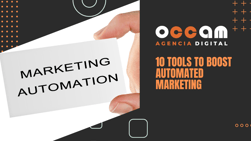Index Content
Automated marketing, also called marketing automation, is an updated way of carrying out some of the marketing tasks in which part of them are carried out autonomously, without human intervention. To do this, digital software must be used as a base platform where data, tasks, publications and the like are dumped so that it can manage, order, publish and analyse them itself.
What is automated marketing?
It is, therefore, the incorporation of a new digital operator to the marketing team that works independently and lightens the workload exponentially. It is an example of how the technological transition has been implemented in different professions, where marketing and advertising are not the only ones.
The two terms that best sum up automated marketing are independence and speed. Both are essential to achieve the final result, the one for which automated marketing has been so successful: cost reduction. An automated marketing action that is fast but requires personnel to carry it out or review it is not profitable. And vice versa, an action that is carried out independently by the software but takes as long to complete as if it were done by a person, or even longer, is not profitable for the company.
Therefore, the cost reduction achieved through automation only affects part of the work, not all functions. These tasks, which are taken care of by the software, are the most mechanical, painstaking and manual ones; those that, when performed by a human being, can take longer or lead to errors. Examples are:
- Creating and managing databases : of clients, budgets, functions, places, tasks... A database is the maximum expression of organisation and its digital transition reduces all kinds of errors that a human hand could make. In addition to, as we said, exponentially reducing work time and even allowing the work of several people at the same time thanks to collaborative tools. The great revolution of data, moreover, is that they are analysed in real time.
- Organisation: calendars, forecasts, reminders... Any organisational and administrative task can now be carried out by software.
- Customer segmentation: this can also be automated, as part of the actions of digital databases. The system divides customers into groups (stages of the buyer's journey, age, buyer persona) making it easier for the company to individualise marketing and communication strategies.
- Attracting and converting leads: How was it previously possible to get a customer passing through a shop to give their details? They were asked for them at the till, at the entrance or as a price for a small gift. However, these techniques are much less effective than the new lead acquisition strategies that are being implemented with the digital operating system. Technology offers more and more varied options that attract customers and persuade them to give their details. In short, it is more variety and more effectiveness.
- Email: communication with customers improves exponentially with automated marketing: it is faster, achieves a higher influence ratio and can also become personalised as emails are addressed personally to each customer, with their name. These leads are also much more qualified.
- Automation of reports and balance sheets: the task that used to take hours for a worker or a team to carry out is now automatic. Your graphs, comparisons, tables and reports are almost completely done with no room for error.
- Measuring impact and monitoring impact: another task that the company does not have to take care of is accounting for the results of its campaigns, actions, sales or interventions, e.g. calculating ROI and the profitability of the efforts invested by the company.
However, the incorporation of these systems also generates new activities that did not exist before and that are beneficial for marketing strategies, for example, blogs, social networks, land pages and pillar pages, which are the transfer of the company to the digital sphere, with its corresponding benefits, such as an increase in the area of influence, widening of the target, individualisation of communication, cheaper advertising...
how does this translate into cost reduction?
First of all, we should review what is meant by cost: it is not only fixed or variable expenditure in monetary terms, but also time, opportunity cost, or administrative costs.
As we said, the main advantage of automated marketing is to free up workers who previously did manual work and dedicate them to other functions at the same time as those tasks, which reduces the margin of error. Tasks that previously could suffer from errors are now automated and always get the exact result.
Therefore, times are improved, more workers are available to perform other functions and the speed and accuracy with which the work is done is increased, even opening doors to new tools that are beneficial for marketing. All of this translates into increased productivity and efficiency .
However, the software referred to is paid for, and is an added expense, which, however, does not outweigh the new revenue and productivity gains mentioned above. In addition, automation reduces the cost per customer acquisition .
However, the automation of tasks is useless without human ingenuity and human work. What is streamlined is the mechanical work, but the ideas and strategies designed by the workers are irreplaceable and irreplaceable. A task can be automated, but not designed automatically, customers can be segmented but the software does not decide what to do with each group. Thanks to automated marketing, the company, in the same way, obtains better results but does not define what to do with them.




